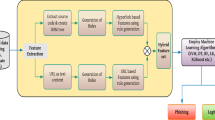Abstract
With the data retrieved from the search engines of Yahoo and SOGOU, this article aims to study the total backlink counts, external backlink counts and the Web Impact Factors for government websites of Chinese provincial capitals. By studying whether the backlink counts and WIFs of websites associate with the comprehensive ratings for these websites, the article demonstrates that the backlink counts can be a better evaluation measure for government websites than WIFs. At length, this article also discusses the correlation between backlink counts and economic capacity, and illustrates that backlink counts can also be an indicator for economic status.
Similar content being viewed by others
References
Bar-Ilan, J. (2001), Data collection methods on the web for informetric purposes: A review and analysis, Scientometrics, 50(1): 7–32.
Berners-Lee, T., Hendler, J. (2001), Scientific publishing on the “semantic web”, Nature, 410: 1023–1024.
Björneborn, L., Ingwersen, P. (2004), Toward a basic framework for webometrics, Journal of the American Society for Information Science and Technology, 55(14): 1216–1227.
Informationization Office Of State Council (2006), Evaluation of Chinese government websites. Retrieved February 15, 2007 from http://www.xxhbg.com/Index.htm.
Garfield, E. (1995), The Impact Factor, Retrieved January 23, 2007 from http://www.isinet.com/isi/hot/essays/journalcitationreports/7.html.
Harter, S., Ford, C. (2000), Web-based analysis of E-journal impact: Approaches, problems, and issues, Journal of the American Society for Information Science, 51(13), 1159–1176.
Ingwersen, P. (1998), The calculation of Web Impact Factors, Journal of Documentation, 54(2): 236–243.
Larence, S., Giles, L. (1999), Accessibility and distribution of information on the web, Nature, 400: 107–110.
Mackiernan, G. (1996), CitedSites(sm): Citation indexing of web resources, Retrieved January 11, 2007 form http://www.public.iastate.edu/:_CYBERSTACKS/Cited.htm.
Madnick, S., Siegel, M. (2002), Seizing the opportunity: Exploiting Web aggregation, MIS Quarterly Executive, 1: 35–46.
Qiu, J., Chen, J., Wang, Z. (2004), An analysis of backlink counts and Web Impact Factors for Chinese university websites, Scientometrics, 60(3): 463–473.
Smith, A., Thelwall, M. (2002), Web Impact Factors for Australasian universities, Scientometrics, 54(1): 363–380.
Tang, R., Thelwall, M. (2002), Exploring the pattern of links between Chinese university Web sites, Proceedings of the ASIST Annual Meeting, 39: 417–424.
Thelwall, M. (2001a), Extracting macroscopic information from web links, Journal of the American Society for Information Science and Technology, 52(13): 1157–1168.
Thelwall, M. (2001b). Exploring the link structure of the Web with network diagrams, Journal of Information Science, 27(6): 393–402.
Thelwall, M. (2002), A comparison of sources of links for academic Web Impact Factor calculations, Journal of Documentation, 58(1): 60–72.
Thelwall, M., Harries, G. (2003), The connection between the research of a university and counts of links to its web pages: an investigation based upon a classification of the relationships of pages to the research of the host university, Journal of the American Society for Information Science and Technology, 54(7): 594–602.
Thelwall, M., Vaughan, L., Björneborn, L. (2004), Webometrics, Annual Review of Information Science and Technology, 81–135.
Vaughan, L. (2004), Web hyperlinks reflect business performance: A study of U.S. and Chinese IT companies, Canadian Journal of Information and Library Science, 28(1): 17–31.
Vaughan, L., Hysen, K. (2002), Relationship between links to journal web sites and Impact Factors, ASLIB Proceedings: New Information Perspectives, 54: 356–361.
Vaughan, L., Shaw, D. (2003), Bibliographic and Web Citations: What is the Difference? Journal of the American Society for Information Science and Technology, 54(14): 1313–1322.
Vaughan, L., Shaw, D. (2004), Can Web Citations Be a Measure of Impact? An Investigation of Journals in the Life Sciences, Proceedings of the 67th ASIS&T Annual Meeting, 41: 516–526.
Vaughan, L., Thelwall, M. (2003), Scholarly use of the web: What are the key inducers of links to journal web sites? Journal of the American Society for Information Science and Technology, 54(1): 29–38.
Vaughan, L., Wu, G. (2004), Links to commercial websites as a source of business information, Scientometrics, 60(3): 487–496.
Author information
Authors and Affiliations
Corresponding author
Rights and permissions
About this article
Cite this article
Yan, E., Zhu, Q. Hyperlink analysis for government websites of Chinese provincial capitals. Scientometrics 76, 315–326 (2008). https://doi.org/10.1007/s11192-007-1923-5
Received:
Published:
Issue Date:
DOI: https://doi.org/10.1007/s11192-007-1923-5




